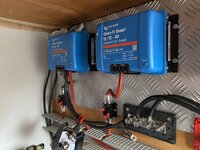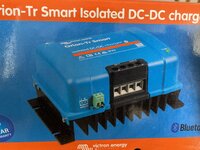PeterCarole29
LIFE MEMBER
I am Fitting 2x30amp chargers that normally you would connect the in coming negative to the starter battery that in turn is to the chassis
Can I fit the incoming negative to the chassis 6 m away
So run the positive from engine battery to the back of the van into the DC to DC charger and then drop the incoming side negative into the negative on the bus bar load side of the victron BMV-712 smart
If I cant can you explain where the problem will arise
Thanks in advance


Can I fit the incoming negative to the chassis 6 m away
So run the positive from engine battery to the back of the van into the DC to DC charger and then drop the incoming side negative into the negative on the bus bar load side of the victron BMV-712 smart
If I cant can you explain where the problem will arise
Thanks in advance



